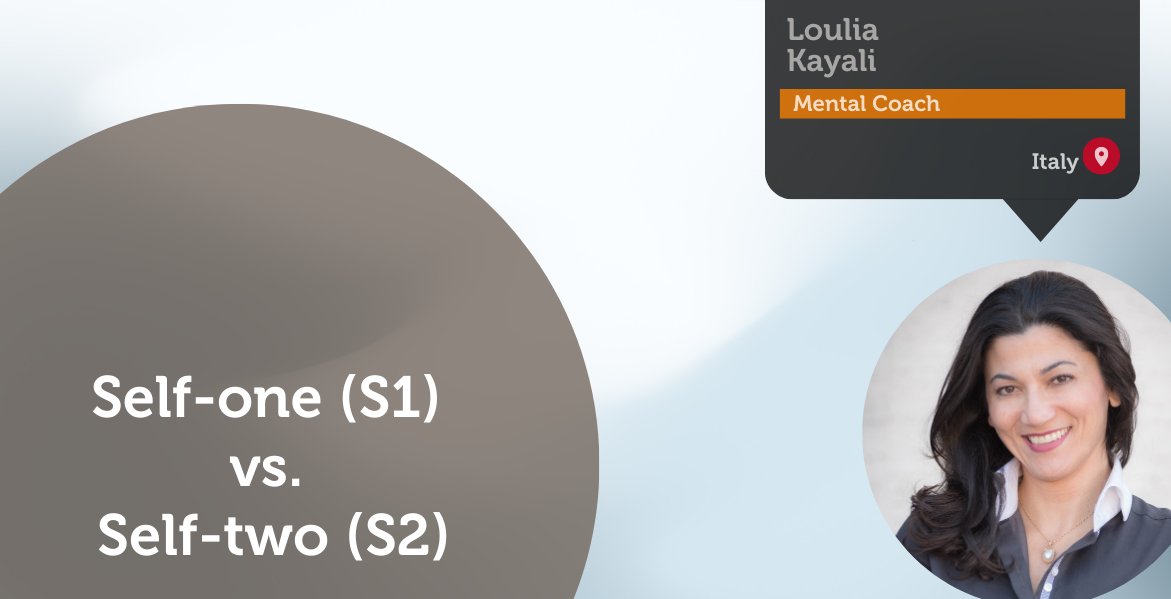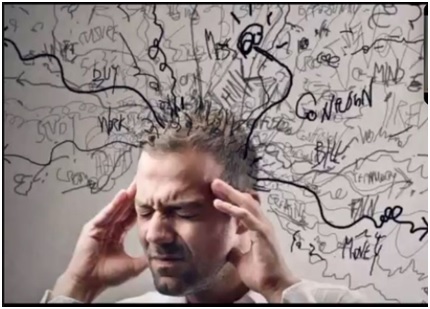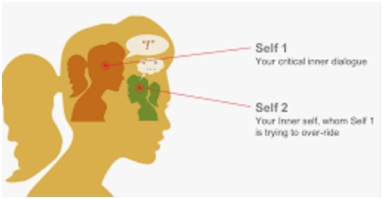A Coaching Power Tool By Loulia Kayali, Mental Coach, ITALY

S1 vs. S2: Self-One vs. Self-Two
 Me, myself, and I. Are they incredibly terrible and different people? Or just one amazing person who tries to understand what’s going on?
Me, myself, and I. Are they incredibly terrible and different people? Or just one amazing person who tries to understand what’s going on?
Shshshshsh … I hear lots of voices out there. Who’s talking?? Oops, it’s between me and myself. REALLY!!
S1: You won’t make it
S2: Why? I know I want to get there
S1: You can’t, you’re not strong enough. You’re not the person that you think you are!
S2: But why? What do you mean? I feel I can do it
S1: Well, it’s not easy and many people have failed before you …remember!
S2: Maybe you’re right, my mom said so one time. I’m a bit hesitant! But wait, something inside me is telling me that I can move forward
S1: Mm, then prove it. Tell me, what are you going to do and where would you start?
S2:Oh, that’s a difficult one. I’m not sure. I know it’s not easy and I’m afraid of failing. I’m also blocked and can’t move.
S1: YES, see!!… I told you you’re not good enough! Follow me and let me take the lead
S2: Uhhh, now what? I have many doubts and concerns. I lost my self-confidence, motivation, and my passion to follow my dreams. So that’s it! Am I never going to be able to get there?
That was a dialogue I personally had with myself in one of my past experiences before starting my coaching path and becoming a coach. More than 10 years passed before I realized I was not managing my inner game, and I was simply letting S1 (MyJudge) control and leading the situation ignoring my feelings and underestimating the ability of S2 (my true self). It only caught my attention when I started to have more awareness of my thoughts, beliefs, and actions. And how we, most of the time, get in our way impeding ourselves from moving forward in life to follow our dreams. We also block our natural learning when we lose our game.
The Inner Game, as described by T. Gallwey[1]:
is a game that takes place in your head and in your heart. It’s all the internal obstacles that take place within a person and their trust in their own potential.
The inner game can not be played because we all have our interference going continuously in our heads and in our hearts. So, in overcoming fears, doubts, and lapses the person can access their potential to perform in any given arena.
This tool proved to be one of the most powerful self-help tools. Wise management of your inner game supports you in better playing your outer game (any external event or situation that might encounter you).
We all have two selves. let’s have a look who are they? And where do they come from?
 S1 vs. S2 Definition
S1 vs. S2 Definition
Self-One (the conscious ego mind)
The inner dialogue described above shows that S1 is all our interferences (voices) going in our heads about how we should behave and what we should or shouldn’t do. What’s right and what’s wrong? These voices create such judgemental behavior against us adding more obstacles and blame to ourselves through a negative inner dialogue.
We, human beings, create this behavior over time from what we’ve received from our surroundings. It clearly inhibits individual growth, self-awareness, or opportunity for taking action and moving forward fearing to make any mistake or to fail.
Have you ever watched, carefully, a small kid two years old while he’s walking or running (inaction)? What would happen if his foot catches on something and he stumbles or falls down on the floor? Would he think he’s a failure because he couldn’t walk or run properly? Would he be worried about what people would think about his fall? Not at all. He might cry if he hurts himself, otherwise, he will simply get up again and continue walking, but he won’t think for a second of anything or anyone.
He doesn’t have interferences or judgments (no S1).
Self-Two (the true self you were born with)
The truthful side leads you to behave in a very natural way like a child. Whenever you find yourself performing spontaneously in a natural way, this is YOU. Following your inner voice in a very smooth manner without trying so hard to do what you’re doing, this is YOU. Feeling trust and confidence in what you’re doing no matter how difficult it is, this is YOU.
S2 performs at its best when our EGO/S1 is absent, which means that the mind is calm and focused.
 S1 (your conscious ego-mind) likes, continuously, to tell S2 (you and your potential) what it should and shouldn’t do.
S1 (your conscious ego-mind) likes, continuously, to tell S2 (you and your potential) what it should and shouldn’t do.

Therefore, any person’s mind becomes full of instructions of DOs and Don’ts, SHOULDs, and SHOULDN’Ts. Consequently, this creates stress and stiffness in the person while trying hard to do the should and not to do the shouldn’t in any situation blocking them (S2) from proceeding toward any goal. In this case, people start criticizing themselves when they make mistakes rising their judgemental attitude (S1) versus themselves.
Since judgment is human behavior and interferences are constant, regardless of what cultural background or professional profile people are from, they will still play this game in their heads. However, during several sessions, I noticed that the client does not come to the session with the awareness of this dialogue and wanted to change it. It automatically comes up during the session. As a result, it’s the role of the coach to identify this aspect and help the client notice it, and how it is blocking them and impeding them from reaching what they want to achieve.
You need to conquer your inner game first to move for success
The best performance happens when the mind is not thinking or trying to do anything. It is at that moment when the attention is focused.
Challenges:
The inner game requires faith and a strong feeling of wanting to unlearn bad habits. It demands that we value awareness, consciousness, and paying attention to what’s happening within and around us. The secret here lies in firstly increasing awareness about the thing you want to change. In a similar way, if I ask you right now to become more aware of how you’re sitting while reading this page, it’s most likely that you’d make subtle changes in your body’s position if you felt anything that was less than comfortable.
It’s important to know that no one planted you in a place that you don’t want to be. You certainly can choose to move as any independent aware person once you know where you want to be.
In accordance with one of ICA’s power tools “Truth vs. Fraud”, knowing what you truly want for yourself enables a minimum relationship with yourself. While ignoring what you truly want in favor of pleasing others, or simply choosing what’s convenient creates discomfort and frustration. Living up to your truth requires boldness in chasing what you want, and not simply taking what you get or what you’ve been offered.
S1 vs. S2 Self-Application
Drawing on one of my inner resources (courage), I designed this way of thinking:
Shifting from what’s right and what’s wrong, to I don’t know let’s explore and learn.Shifting from what should be done and what shouldn’t, to just enjoying life and experimenting with other opportunities. Shifting from I live up to what exists and take what I get, to live my reality sincerely and truly.
Listening to S1 puts me in a state of lack, scarcity, and limitation from taking any risk and from experiencing any new opportunity out there while trusting S2 felt a state of freedom and abundance that also boosted a sensation of gratitude.
The Appreciative Inquiry module highlights that:
Rather than seeing language as a passive purveyor of meaning between people, postmodernists see language as an active agent in the creation of meaning. As we talk to each other, we are constructing the world we see and think about, and as we change how we talk we are changing that world.
As a Coach, I see that the alphabet in any language has a limited number of Letters from which we can create an infinite number of words to tell ourselves. While shifting a perspective, the Coach’s role is not to teach or provide advice to the client, instead is to help them learn by themselves from their stories. And I’d love to support my clients to switch their attention from scarcity to abundance by simply giving them the space to pause and take a deep breath. Then, to bring their awareness to the present moment and ask them to carefully choose the words that help them create the reality, they really want.
Any person can create their world through their language by simply identifying the words that will shape their thoughts, behaviors, and actions.
Some powerful questions:
- What can you say instead?
- What are you noticing here?
- How does this help you reach your goal?
- What would happen if you stopped thinking and controlling, but listened to the little child inside you giving him the possibility to explore and enjoy what he’s doing?
Finally, the change theory says: If you change the stories, you change the inner dialogue. Nothing from what the “rational mind” wants will actually happen if the “inner dialogue” is resistant to it.
References
Gallwey W. T.(1974). The Inner Game of Tennis. The ultimate guide to the Mental Side of Peak Performance. Electronic edition published 2015 by Pan Books, UK.
Truth vs. Fraud, ICA Coaching power tool, PT. ICA Learnsite (2019).
The Appreciative Inquiry (AI). ICA Frameworks and Theories.ICA Learnsite (2019).
What is the inner game? A revolutionary way of learning tennis. On the following link
[1]Timothy Gallwey is The Founder of The Inner Game and is widely acknowledged as the godfather of the current coaching movement.